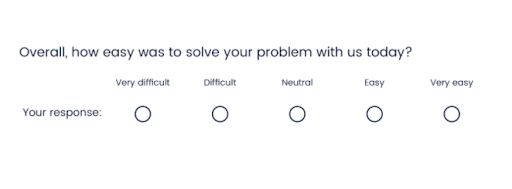
Did you know that 1 out of every 3 customer calls is from a repeat caller?
These calls are often from customers who were not satisfied with the solution they received the first time. So when your day is jam-packed with such calls, how do you delight customers?
By focusing on first call resolution (FCR), your business can avoid repeat or follow-up calls, enhance agent productivity, save time, and increase customer satisfaction.
Many businesses handle thousands of calls every month. Improving the first call resolution rate by a few percent can have a huge impact on the bottom line. When customer issues are resolved in the first contact, it shows respect for their time and concerns, leading to higher satisfaction and more trust.
If you are thinking about introducing FCR to your support process, you have come to the right place. In this blog, we will define FCR, look at its benefits, and explore tips on how to improve your first contact resolution.
Let’s go!
What Is First Call Resolution?
First call resolution refers to the percentage of customer issues, queries, or complaints that are resolved in the first call. The customer does not need to make follow-up calls to get a solution as a single contact is sufficient.
FCR is a popular, globally-recognized metric that is considered a key driver of customer success. A high FCR rate can help you reduce operational costs, retain customers, and identify your top-performing agents.
On the other hand, if a customer has to call your team multiple times for the same issue, it raises serious questions about agent knowledge, escalation rules, the technology used, workforce distribution, and more.
What Is First Contact Resolution?
First contact resolution refers to the number of customer issues or inquiries that are resolved in the first attempt. FCR is used to monitor customer service performance on multiple channels such as live chat, email, phone, social media, etc.
- For phone support, it means resolving the customer issue in a single call session.
- For email and social media platforms, it means resolving the problem using a single response.
- For live chat, it means resolving a customer problem in a single chat session.
How to Calculate First Call Resolution
The first call resolution calculation is fairly simple. You can either do it manually or use an automated help desk software to do it for you.
Here is the formula to calculate the first call resolution rate:
FCR = The total number of support calls that are resolved in the first attempt, divided by the total number of calls received in a given time period.
Let us understand this better with the help of a first call resolution example:
Let’s assume Company X received 1,200 customer service calls in the month of March. Now, 720 of those calls were resolved on the first attempt. The FCR rate, in this case, would be:
720/1200 X 100 = 60%
|
Note: The higher your first call resolution rate the better your team’s performance. A “good” FCR usually ranges between 65% to 75% but can differ from one industry to another. For example, the average FCR rate is highest for retail at 78% and lowest for telecom at 61%. For best results, your customer support team should set their FCR goal above 80% to achieve the best results.. |
Why Is First Call Resolution (FCR) Important?
Customer service teams across the globe focus on FCR. But why is this particular metric so important? Here are some reasons why the importance of first call resolution should not be overlooked:
1. Reduce Operational Costs
It is true that every customer call is costing your business some amount of money. The labor cost ranges from $1.11 to $3.29 for a three-to-four-minute direct consumer call. Moreover, there are additional costs for infrastructure, rent, software, and so on. When a majority of customer service calls are handled on the first attempt, you can avoid follow-up calls and save time and money.
2. Retain More Customers
Good customer service has a big influence on customer retention. According to a study, friendly customer service agents who deliver memorable experiences, encourage 73% of customers to stay loyal to a brand. A high FCR rate will help you reduce customer efforts significantly and encourage them to buy again from your brand.
3. Improve the Customer Experience (CX)
Resolving customer problems in the first call is a home run for your business. Increased FCR can translate into increased customer satisfaction and increased referrals. Customers who have a delightful support experience will not mind sharing the same with their friends and family – bringing in more prospective customers to your business.
4. Focus on Other Tasks
Let’s be honest, customer service agents have a lot on their plates – never-ending email threads, walk-in customers who need assistance, live chat messages, and so on. When you prioritize a help desk metric such as FCR, you can empower your agents to handle phone calls quickly and devote more time to other important customer service channels. Moreover, with the saved time, they can benefit from other important activities such as training, meetings, etc.
Read More: Choose the Best Customer Support Channels for Your Growing Business
Challenges of Improving First Call Resolution
Improving your FCR is not child’s play. There are multiple obstacles that you need to overcome from time to time. Let’s explore the top barriers to improving first-call resolution.
- Long Hold Times: It is neglectful to put your customers on hold for too long. If a customer has to spend more than 2-3 minutes before they are connected to a support agent, then you are spoiling their experience. Long hold times can impact your FCR rate and lead to customer churn.
- Agents Who Lack Knowledge: Customers love to interact with agents who possess the relevant knowledge and skills needed to resolve any issue. A lack of knowledge about the issue in general or the product/service will make the customer lose trust in your business.
- Poorly Designed IVR Menu: The IVR has revolutionized how modern call centers operate. However, a poorly designed IVR system can make it difficult for customers to get their issues resolved in the first call. They will be connected to the wrong department and forced to make repetitive calls.
- Lack of Agent Authority: For many customer service teams, agents do not have the authority to take matters into their own hands. For example, they cannot share discount coupons with customers or initiate a refund. In such cases, the customer is either asked to wait or connected to a senior representative.
First Call Resolution Best Practices
So how do you improve first call resolution? Here are 8 FCR best practices that will help your team delight and retain customers.
1. Automate Ticket Routing with Help Desk Software
Do some agents in your team handle more calls than others? Are there many customer calls that go unanswered? If yes, then your business needs to create smart routing rules using the best help desk software.
Automated ticket routing refers to the process of assigning support tickets to agents based on their availability. These tickets can be created from customer phone calls, emails, live chat messages, and other channels.
With a proper call or ticket routing process, you can ensure that no customer issue goes unnoticed. Every customer problem will have an appropriate owner who should strive to resolve the issue in the first attempt.
Moreover, help desk software can offer deep insights into your support performance. You can create daily, weekly, and monthly reports to track metrics such as first contact resolution, average first response time, ticket resolution time, agent ratings, and more.
2. Understand the Customer’s Needs
As soon as you are done greeting the customer, you need to carefully listen to what they have to say. Active listening can help you gather more information about an issue and offer the best solution.
If you want to improve first call resolution, you need to drop the “know it all” attitude. Before you start addressing customer issues, spend some valuable time getting to know the unique challenges they might be facing.
Here are some questions you can use to better understand customer needs:
- What is your main reason for contact today?
- When did you first face the issue?
- How frequently are you experiencing the problem?
- Do you have any idea what might have led to the problem?
- How has this problem impacted your work/activity?
- What challenges did you encounter when you tried X?
- Are there any other relevant details that you would want me to know?
The right blend of these probing questions will make it easier for the agent to understand all details pertaining to the issue and answer all customer questions.
3. Set the Right Expectations
Once you have dug deep enough to understand the problem of your customer, you must convey when they can expect the problem to be resolved.
Whenever you are on a call with a customer, it is important to set the right expectations at different points. You must clearly communicate about the actions you are taking and how much time it might take.
Let’s understand this with the help of some examples:
Example 1: When a customer has a query about a bill:
“I’m going to look into your bill for the items purchased on 6th March. It should not take me more than two minutes. Can I put your call on hold for a moment?”
Example 2: When a customer has shared a challenging problem:
“This issue is a bit complicated. Let me quickly connect with my manager and get your issue fixed. It should not take more than two minutes. I appreciate your patience.”
Example 3: When a customer wants to know about your return policies:
“I have shared a link to our knowledge base article that covers all our return policies. Please check your email account and let me know if you received it.”
Such statements will help you set the right expectations and let the caller know you value their
time.
Read More: 50+ Customer Service Scripts for Your Team
4. Create a Self-Service Knowledge Base
If your team is receiving phone calls on repetitive issues, it will be wise to create an online repository that includes relevant solutions to those problems.
For example, your self-service knowledge base can include answers to common questions such as, “How do I change my account password?”, “What are the returns and exchanges policies?”
Before you get your knowledge base live, there are some points you need to remember:
- Make it SEO-friendly so that customers can easily find your FAQ pages or help articles on the web
- Considering that a majority of customers use smartphones, your KB should cover multiple devices including mobile and tablet
- Add and update your content from time to time
When you have a well-curated knowledge base, agents can easily share links via email or chat and ensure your team archives a better FCR rate.
5. Train Your Agents
Many customer service experts consider training as one of the best first contact resolution tips for agents. A well-trained team can not only resolve customer issues promptly but also ensure they have a delightful experience.
Your support staff should be well-informed about the products and services you sell. Moreover, you need to train them to handle difficult queries and angry customers.
If you are a growing business whose products and services are constantly changing, you need to ensure all your support agents are on the same page. After all, 62% of customers find service insight and knowledge key to a good experience.
To improve your FCR rate, you need to recognize and appreciate agents who are constantly achieving or exceeding their targets. This is a good way to motivate your team and set the right example for everyone to follow.
6. Give More Power to Agents
Your call center agents are superheroes who are dealing with the most difficult situations day in and day out. Even a single call with an angry customer can take their mood downhill.
In order to delight customers, you need to give more power to your support staff members. Allow them to handle high-priority issues on their own, ask them for suggestions, and offer them great work flexibility.
Let’s explore these points in more detail:
- Escalate Issues Only When Necessary: Ticket escalations always mean two things – the involvement of more agents and added frustration for the customer. To improve your first call resolution rate, you must train your agents to handle difficult calls without the need for escalation. Keep in mind most customers hate being thrown around from one agent to the next.
- Take Feedback: Sometimes reps can know more about what works for customers than the “expert strategists.” Therefore, you need to involve them in monthly or quarterly team meetings and ask them what they feel needs to be improved.
- Offer Work Flexibility: To enhance the productivity of your support staff, you must offer them work flexibility. If someone in your department is a night owl, you can allow them to work night shifts. Similarly, based on your situation, you can even allow work-from-home facilities to employees who need them the most.
Read More: 16 Tips for Managing a Remote Customer Service Team
7. Share Post-Call Surveys
As a first call resolution best practice, you must share customer satisfaction or other feedback surveys with your customers. But what exactly is a post-call survey?
A post-call survey, as the name suggests, is a small survey shared with the customers after the end of a call. You can share it via email, text message, or an automated phone call.
Now you might wonder why is this even helpful? Well, on one hand, you can monitor the customer experience using CSAT surveys (How satisfied are you with the overall experience of our service?). On the other hand, you can monitor agent performance (On a scale of 1-5, how would you rate the knowledge of our call center agent?).
There can be situations where a customer marks a query or issue as resolved right after the first call. However, a survey can help you get insights into the customer’s perspective and understand whether the problem was actually resolved or not.
Read More: Customer Satisfaction Surveys: 100+ Questions & Examples
8. Prioritize Delight Before FCR
Blindly prioritizing the first call resolution metric can also lead to customer loss. While it is crucial to identify and monitor metrics, it should not be the only focus.
When agents are told to prioritize FCR strictly, they might become more focused on solving the problem as quickly as possible than building a strong relationship.
It is important to build the right culture for your team. Teach support agents about the value of customer service skills such as empathy, patience, ownership, trust, etc., which are often hard to quantify.
At the end of the day, every agent’s priority should be to delight the customers and not simply end the call to achieve their set “targets.” This way, customers won’t feel as though they are being treated as tickets and will enjoy more meaningful conversations with your support team.
Read More: 31 Important Customer Service Skills
Other Important Call Center Metrics Like FCR
While FCR is an important metric to track your customer service team’s performance, it is not the only one. There are multiple metrics that you can choose based on your objectives, team size, and customer service culture.
- Average Hold Time: This is an important call center metric that shows you the average time spent by callers in queue, waiting to be connected to a support representative.
- Average Cost Per Support Call: This tells you the average cost incurred by your business to handle support calls. The cost can include agent salaries and costs of software, IVR technology, and other infrastructure.
- Average Handle Time: This metric calculates the average duration of a customer service call. The time begins when the agent picks up the call and ends when the call is disconnected.
- Average After-Call Work Time: This metric denotes the average time taken by agents to finish tasks related to their support call. For example, it can include time spent making notes, speaking to the manager, or writing an email to the customer or other department.
- Call Abandonment Rate: This refers to the number of inbound phone calls that are abandoned by the customer before they get connected to an agent. A high call abandonment rate signals customer frustration due to long hold times.
- Peak Hour Traffic: Peak hour refers to the time of the day when your support team receives the maximum number of calls. By identifying your peak hours, you can allocate adequate resources to handle the demand.
- Occupancy Rates: Occupancy rate is another important contact center metric. It denotes the percentage of time spent by agents speaking to customers as opposed to the time spent waiting for calls during work hours.
Prioritize FCR & Increase Customer Satisfaction
Even the best support teams on the planet cannot solve every customer problem on the first call. Therefore, you need to take it easy and set realistic first call resolution targets for your support team. In addition to FCR, encourage agents to focus on skills such as empathy, active listening, and patience.
Improving FCR can help your business increase customer satisfaction and retention rates. The fewer efforts customers have to put forth to get their issues resolved, the higher the chances they will stick with your brand for the long term.
To increase the first call resolution rate, you must offer consistent training to agents, give them more authority, create a knowledge base, and share post-call surveys with customers. Moreover, by investing in help desk software like ProProfs Help Desk, you can track relevant support metrics for different channels.
FREE. All Features. FOREVER!
Try our Forever FREE account with all premium features!










